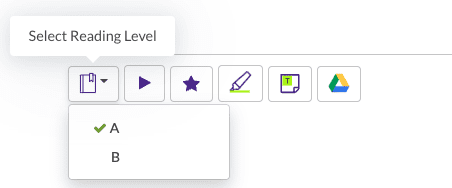
TCI’s commitment to universal access—and our fundamental belief that all children can learn—is shown in these support features.
1. Reading Support
Student reading and notes include built-in support for emerging to advanced readers.

|
Reading Support Buttons allow students to change the text reading level, highlight main ideas, take notes, or use text-to-speech audio. |
 |
Considerate Text has a single-column layout, section titles, and subheads that divide content into meaningful and manageable chunks, carefully structured paragraphs with topic sentences and supporting details, carefully chosen images to support the text, and captions that incorporate main ideas.
|

|
The graphically-organized notes help students record and remember what they read. |
 |
Vocabulary is introduced at the beginning of a lesson, and students complete a Vocabulary activity to practice using the terms. The glossary assists students with essential terms. |
2. Differentiating Instruction
Activities include step-by-step suggestions for meeting the needs of English learners, students below grade level in reading and writing, special education students, and advanced learners within the context of whole-class instruction and with minimal modifications needed on the teacher’s part.
Suggestions for supporting individual learners are available at point of use in TCI’s teaching materials.
3. ELA/ELD Toolkits
Support students who need additional guidance and structure with reading, writing, or vocabulary development with ELA/ELD toolkits. Teachers can use strategies or graphic organizers from TCI’s Reading, Writing, Speaking and Listening, and Vocabulary toolkits as an independent tutorial, for class instruction, or use with peer tutoring.
4. Vocabulary Connections
Vocabulary games, interactive flip cards, class activities, and more—here are different ways teachers can engage students in vocabulary development throughout a TCI lesson.
Assign Vocabulary Games like Powered by Pizza or Adventures in the Sky to review key terms from the lesson.
- Use the Vocabulary Development slide in the Classroom Activity slideshow to formally introduce the vocabulary terms for the lesson.
- Consider using one of the Vocabulary Development Strategies (Illustrated Dictionary, Rate Your Knowledge, Word Grids, or Word Pyramid) with individual students, small groups, or the class.
- Review each term again with students as it appears in the activity, and encourage students to use the terms in their notebook answers.
- Many of the online Check for Understanding questions give students a chance to engage with key vocabulary. The interactions allow students to self-assess their vocabulary knowledge. Consider projecting some of these tutorials and debriefing as a class.
- Have students flip the Vocabulary Cards online to study key vocabulary before taking the summative assessment.
- Each TCI-provided test has built-in questions that test basic and more advanced understanding of key vocabulary.

 Assign Vocabulary Games like Powered by Pizza or Adventures in the Sky to review key terms from the lesson.
Assign Vocabulary Games like Powered by Pizza or Adventures in the Sky to review key terms from the lesson.

